- Joined
- Jun 15, 2017
- Messages
- 579
Today I finished assembling a mobile base for my Gorton 375 grinder. I finally got it off the pallet and rolled it into the workshop. I feel like I cheated death several times.
The design is a little weird. For stability, I wanted the casters to be considerably farther outboard than the sides of the cast iron stand. In order to do this with members running parallel to the sides of the stand, you would have to use a lot of steel tubing, and the large number of welds would provide plenty of opportunity for warpage. I decided to use an X-shaped base with swiveling casters welded to the tubing in order to avoid locating and drilling 32 bolt holes.
The idea of welding the casters to the tubing came from a Jimmy Diresta video. It made life much, much easier.
It's pretty interesting, trying to create an X-shaped rectangular base with the correct angles and so on. Much harder than a square base. Once the welding was done, I had to lower the machine onto the base, line it up as well as possible, and insert a Sharpie into the bolt holes to mark it for drilling. There was just no way to mark it using a square and a yardstick.
I cut halfway through each member and then interlocked them in the center like Lincoln logs. Took quite a while to get the openings right.
Some guy on the web said this grinder weighed around 250 pounds, and he said he unloaded one from his vehicle by himself. He's lying, insane, or on steroids. When I got this thing off the ground using the tractor, I could tell it was really heavy. The freight bill said the grinder and pallet came in at 490#, and I feel sure the shipper actually weighed it instead of letting the freight people make up a number. If the palleted grinder weighed 490#, the grinder alone must weigh around 400. It's also extremely top-heavy, and the weight is concentrated on the right side in the front. When you lift it with a strap and try to put it down, it does its best to lie down on its face instead of standing up. You have to put one corner on the ground and then swing your forks to rock the grinder back onto its feet. Unnerving.
I used 1/2" bolts to attach the grinder to the base. I welded nuts to the underside of the base so I would not have to fiddle with loose nuts while the grinder was hanging from my tractor.
The base is rock-steady. The weight of the grinder doesn't flex it one bit, and you can't make it wobble by pushing it. I plan to use the same tubing to make a base for my table saw.
Now that I have the base installed, I think I'm going to do it over and make it wider and deeper. It would be nearly impossible for a normal human to push this thing over from a standing start, but a determined idiot could get it rolling and topple it by hitting an obstruction. If it weighed 250 pounds, I would not be worried about it, but now that I have a better idea of the actual mass, I think it needs more support. It makes me nervous.
I haven't painted the base. Mounting the grinder on it would destroy any paint except maybe truck bed coating, and I'm leaning toward making a bigger base, so I don't know if painting it is worth the trouble.
I'm not all that impressed with the Gorton stand. The grinder part probably weighs 150 pounds, so most of the weight is the stand. I don't see why you need 250 pounds of iron to hold the grinder up. Maybe I should get rid of the stand and build a better, lighter one that provides more stability. The stand would work well for a bench grinder or a saw. Something light.
As mentioned in another thread, the grinder had bearing problems when I got it. I have cleaned and lubricated the bearings, and in the process, I have become, possibly, the world's most knowledgeable person concerning Gorton 375 spindle bearings and their issues. There was virtually no information on the web when I started looking, so I had to spend a lot of time researching, and I learned way more than I ever wanted to know. I plan on putting the information on the web, because I know other people are having trouble getting help.
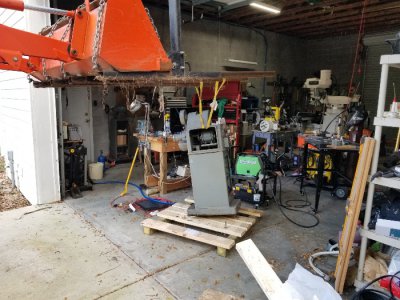
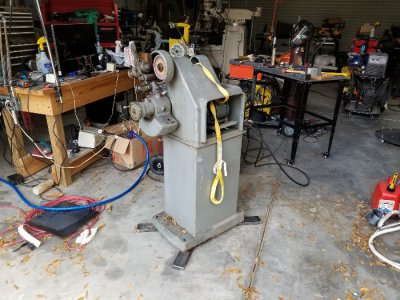
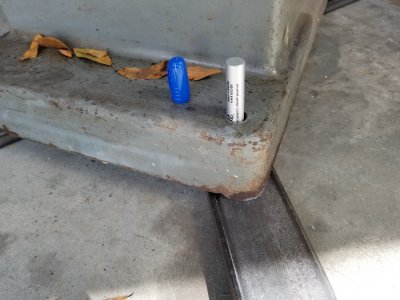
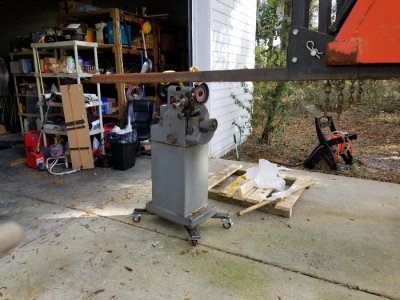
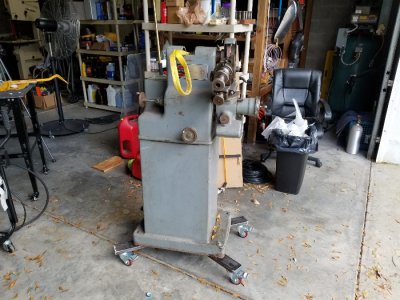
The design is a little weird. For stability, I wanted the casters to be considerably farther outboard than the sides of the cast iron stand. In order to do this with members running parallel to the sides of the stand, you would have to use a lot of steel tubing, and the large number of welds would provide plenty of opportunity for warpage. I decided to use an X-shaped base with swiveling casters welded to the tubing in order to avoid locating and drilling 32 bolt holes.
The idea of welding the casters to the tubing came from a Jimmy Diresta video. It made life much, much easier.
It's pretty interesting, trying to create an X-shaped rectangular base with the correct angles and so on. Much harder than a square base. Once the welding was done, I had to lower the machine onto the base, line it up as well as possible, and insert a Sharpie into the bolt holes to mark it for drilling. There was just no way to mark it using a square and a yardstick.
I cut halfway through each member and then interlocked them in the center like Lincoln logs. Took quite a while to get the openings right.
Some guy on the web said this grinder weighed around 250 pounds, and he said he unloaded one from his vehicle by himself. He's lying, insane, or on steroids. When I got this thing off the ground using the tractor, I could tell it was really heavy. The freight bill said the grinder and pallet came in at 490#, and I feel sure the shipper actually weighed it instead of letting the freight people make up a number. If the palleted grinder weighed 490#, the grinder alone must weigh around 400. It's also extremely top-heavy, and the weight is concentrated on the right side in the front. When you lift it with a strap and try to put it down, it does its best to lie down on its face instead of standing up. You have to put one corner on the ground and then swing your forks to rock the grinder back onto its feet. Unnerving.
I used 1/2" bolts to attach the grinder to the base. I welded nuts to the underside of the base so I would not have to fiddle with loose nuts while the grinder was hanging from my tractor.
The base is rock-steady. The weight of the grinder doesn't flex it one bit, and you can't make it wobble by pushing it. I plan to use the same tubing to make a base for my table saw.
Now that I have the base installed, I think I'm going to do it over and make it wider and deeper. It would be nearly impossible for a normal human to push this thing over from a standing start, but a determined idiot could get it rolling and topple it by hitting an obstruction. If it weighed 250 pounds, I would not be worried about it, but now that I have a better idea of the actual mass, I think it needs more support. It makes me nervous.
I haven't painted the base. Mounting the grinder on it would destroy any paint except maybe truck bed coating, and I'm leaning toward making a bigger base, so I don't know if painting it is worth the trouble.
I'm not all that impressed with the Gorton stand. The grinder part probably weighs 150 pounds, so most of the weight is the stand. I don't see why you need 250 pounds of iron to hold the grinder up. Maybe I should get rid of the stand and build a better, lighter one that provides more stability. The stand would work well for a bench grinder or a saw. Something light.
As mentioned in another thread, the grinder had bearing problems when I got it. I have cleaned and lubricated the bearings, and in the process, I have become, possibly, the world's most knowledgeable person concerning Gorton 375 spindle bearings and their issues. There was virtually no information on the web when I started looking, so I had to spend a lot of time researching, and I learned way more than I ever wanted to know. I plan on putting the information on the web, because I know other people are having trouble getting help.





